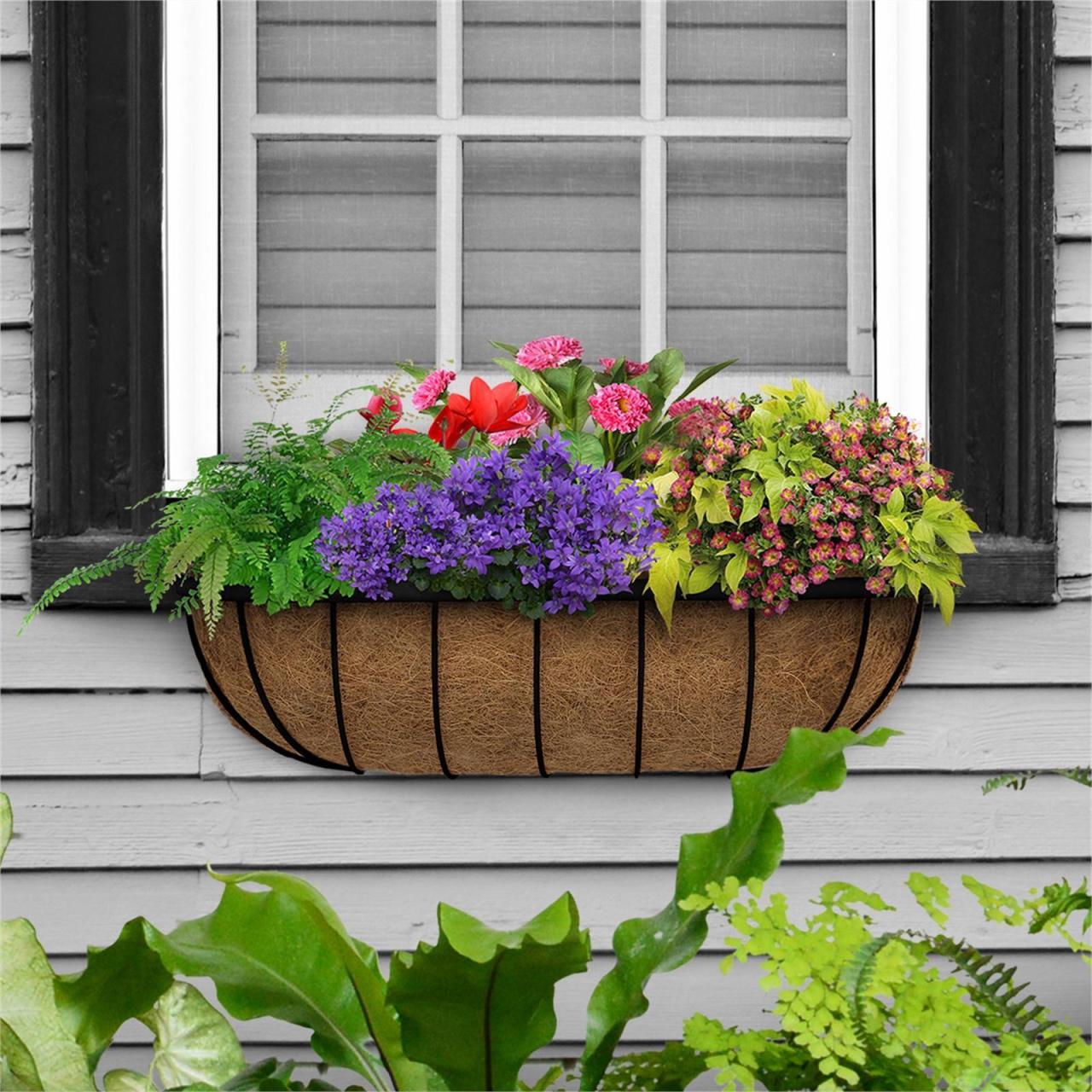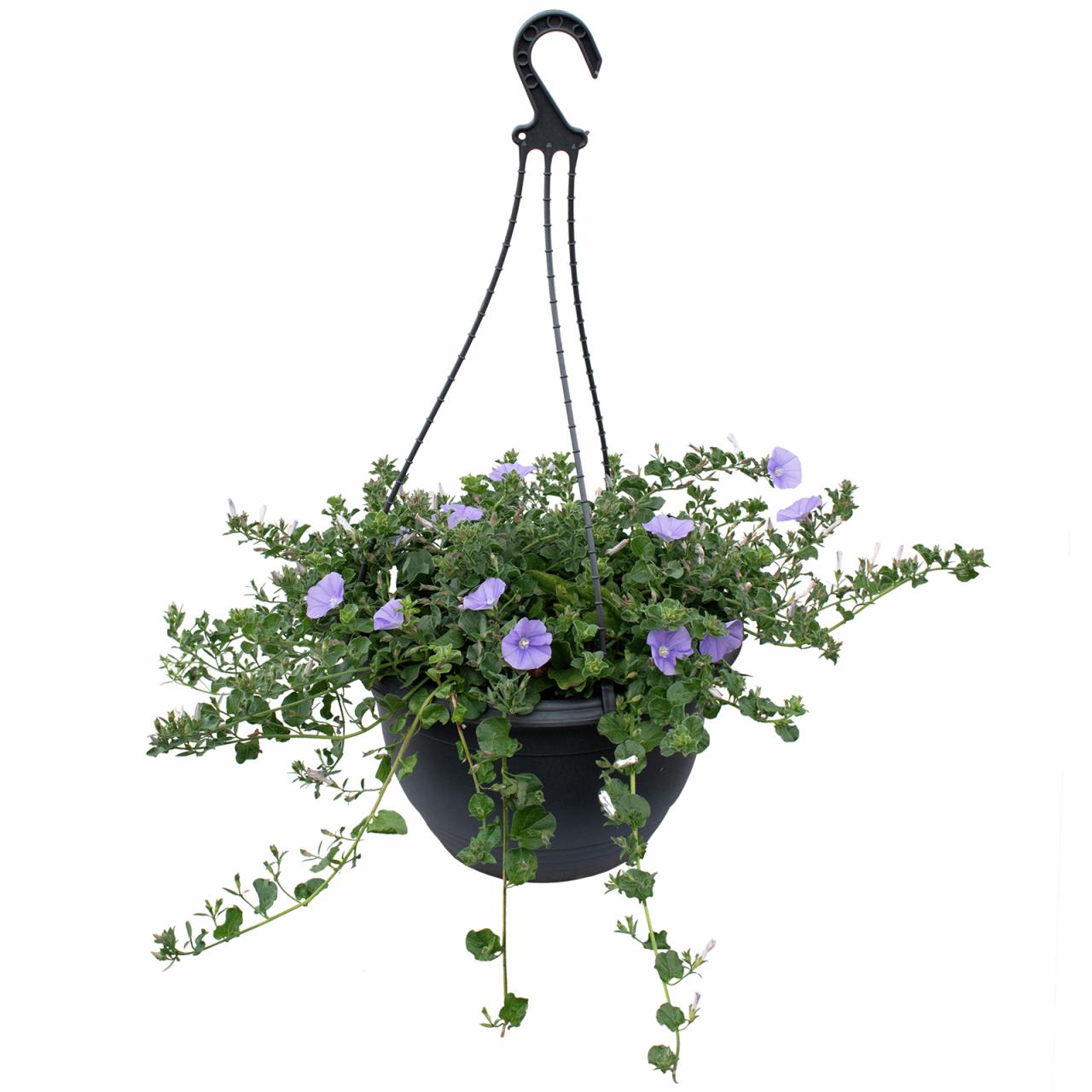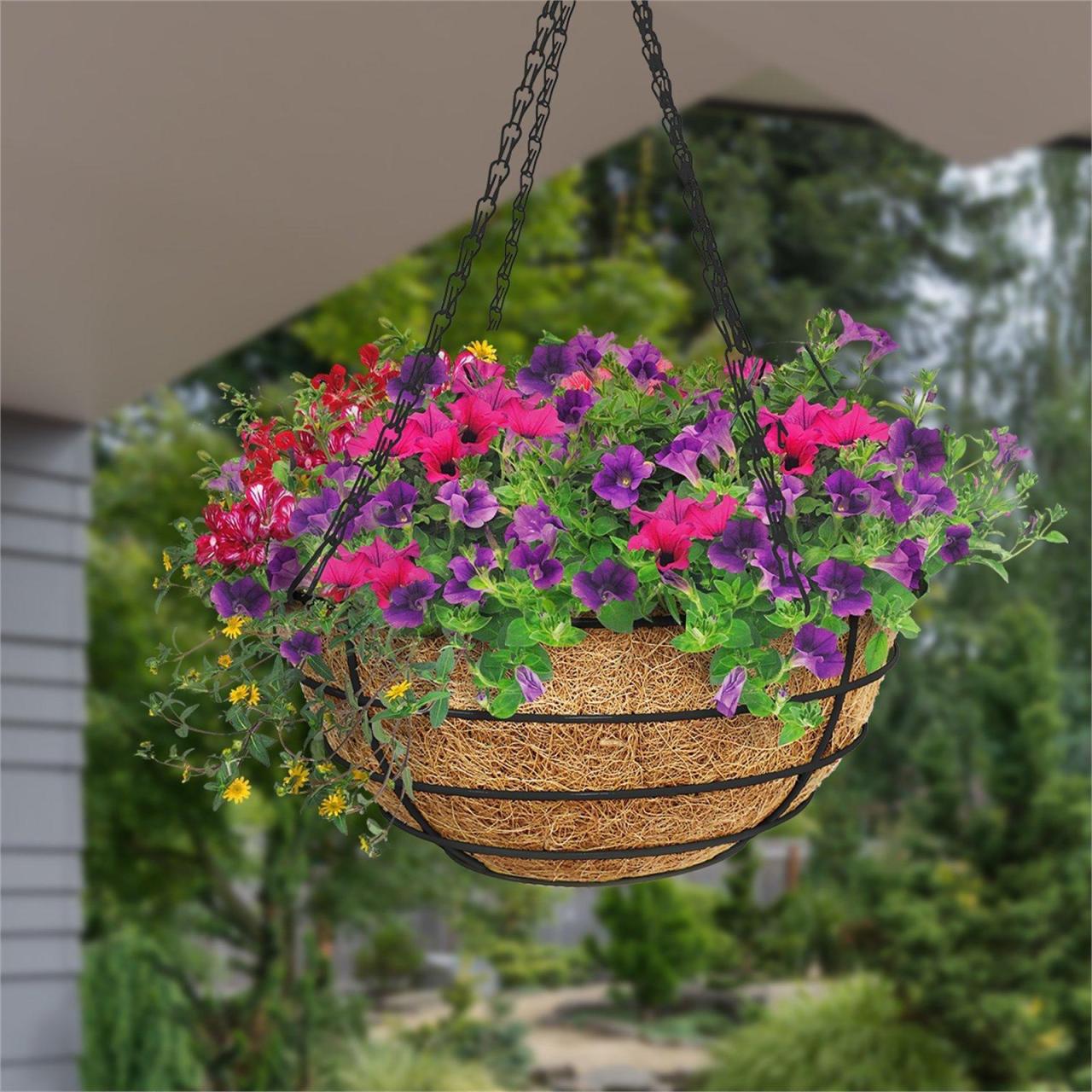Step into the world of Bunnings hanging basket plants, where vibrant colors, captivating textures, and graceful forms intertwine to create a symphony of horticultural artistry. Whether adorning patios, balconies, or indoor spaces, these botanical wonders offer a touch of nature’s elegance to any setting.
From the cascading tendrils of ivy to the delicate blooms of petunias, Bunnings hanging basket plants present a diverse array of species, each with its unique charm. Join us as we explore the enchanting world of these aerial gardens, providing insights into their varieties, design principles, and care requirements.
Plant Varieties and Features

Bunnings offers a wide selection of hanging basket plants that cater to diverse gardening needs and preferences. These plants, adorned with vibrant blooms and lush foliage, add a touch of natural beauty and charm to any outdoor space.
Each variety boasts unique characteristics that set it apart. Some showcase eye-catching foliage, while others captivate with their colorful blooms in various shapes and sizes. Understanding the growth habits, blooming seasons, and sunlight requirements of these plants is crucial for ensuring their optimal growth and well-being.
Flowering Basket Plants
- Fuchsias( Fuchsiaspp.): Known for their elegant, pendant blooms in shades of pink, purple, and white. They thrive in partial shade and bloom profusely throughout summer.
- Petunias( Petuniaspp.): A popular choice for vibrant color, petunias produce trumpet-shaped blooms in a wide range of hues, including red, pink, blue, and yellow. They prefer full sun to partial shade.
- Calibrachoa( Calibrachoaspp.): Also known as million bells, these plants produce masses of small, bell-shaped flowers in shades of pink, purple, yellow, and white. They thrive in full sun to partial shade.
- Geraniums( Pelargoniumspp.): Geraniums offer a long blooming period, with clusters of saucer-shaped flowers in shades of red, pink, white, and purple. They prefer full sun to partial shade.
- Impatiens( Impatiensspp.): Impatiens thrive in shady areas, producing colorful blooms in shades of pink, red, orange, and white. They are known for their continuous blooming habit.
Foliage Basket Plants
- Ferns( Pteridophyta): Ferns add a touch of elegance with their delicate fronds in various shapes and sizes. They prefer shady or partially shaded areas.
- Ivies( Hederaspp.): Ivies are known for their trailing stems and glossy, variegated leaves. They tolerate both sun and shade.
- Spider Plants( Chlorophytum comosum): Spider plants produce long, arching leaves with variegated patterns. They thrive in bright, indirect light.
- String of Hearts( Ceropegia woodii): This unique plant features heart-shaped leaves connected by delicate stems. It prefers bright, indirect light.
- Succulents( Crassulaceae): Succulents, such as echeverias and sedums, offer a wide variety of shapes, textures, and colors. They prefer full sun to partial shade.
Hanging Basket Design and Aesthetics
Creating visually stunning hanging baskets requires careful consideration of design principles and plant selection. This article provides guidance on achieving a harmonious balance of color, texture, and height, along with techniques for creating captivating cascading, trailing, and overflowing effects.
Bunnings offers a wide variety of hanging basket plants, perfect for adding a touch of greenery to your home. For those looking for a convenient way to hang their plants, plant pulleys are also available at Bunnings. These pulleys make it easy to adjust the height of your plants, ensuring they get the perfect amount of sunlight.
With a variety of sizes and styles to choose from, you’re sure to find the perfect hanging basket plants and plant pulleys for your home at Bunnings.
Plant Combinations
When selecting plants for hanging baskets, consider their complementary colors, textures, and heights. Warm colors, such as reds, oranges, and yellows, create a vibrant and cheerful display, while cool colors, such as blues, greens, and purples, evoke a sense of tranquility.
Mixing different textures, such as smooth foliage with variegated leaves or delicate flowers with coarse stems, adds depth and interest. Varying plant heights creates a dynamic display, with taller plants in the center and trailing varieties cascading over the edges.
Cascading, Trailing, and Overflowing Effects
To achieve a cascading effect, select plants with long, flowing stems, such as petunias, lobelia, and vinca. For a trailing effect, choose plants with flexible stems that can gracefully hang over the edges of the basket, such as ivy, dichondra, and ferns.
Overflowing effects can be created by planting a dense mass of plants that spills over the sides of the basket, such as geraniums, impatiens, and begonias.
Decorative Elements
Incorporate decorative elements to enhance the aesthetics of your hanging baskets. Ribbons and bows in complementary colors can add a touch of elegance, while moss can create a natural and earthy look. Consider using different textures and materials, such as burlap, lace, or wire, to add visual interest and depth.
Planting and Care s
Hanging baskets require proper planting and care to thrive and showcase their beauty. Follow these guidelines to ensure the health and longevity of your hanging basket plants:
Soil Composition
- Use a well-draining potting mix specifically designed for hanging baskets.
- Add organic matter such as peat moss or compost to improve soil structure and water retention.
- Avoid using garden soil as it can become compacted and waterlogged.
Drainage
- Hanging baskets must have adequate drainage to prevent root rot.
- Choose baskets with drainage holes or line the bottom with a layer of gravel or broken pottery to facilitate drainage.
- Never allow water to pool in the bottom of the basket.
Watering
- Water hanging baskets regularly, especially during hot, dry weather.
- Check the soil moisture by sticking your finger in the soil; water when the top inch is dry.
- Water thoroughly until water drains from the drainage holes.
Fertilizing
- Fertilize hanging baskets every 2-3 weeks with a balanced liquid fertilizer.
- Follow the instructions on the fertilizer label for dilution rates.
- Avoid over-fertilizing, as this can burn the plants.
Pruning
- Regularly prune hanging baskets to remove dead or damaged foliage and encourage new growth.
- Pinch back trailing stems to promote bushier growth.
- Prune plants back heavily in late winter or early spring to prepare for the next growing season.
Troubleshooting Common Problems
- Yellowing leaves:Indicates overwatering or nutrient deficiency.
- Brown leaves:Indicates underwatering or sunburn.
- Root rot:Occurs due to overwatering or poor drainage.
- Pests:Aphids, spider mites, and whiteflies can infest hanging baskets; treat with insecticidal soap or neem oil.
Seasonal Maintenance and Winter Protection
Hanging baskets require special care during different seasons:
- Spring:Fertilize and water regularly; replant if necessary.
- Summer:Water frequently and provide shade during the hottest part of the day.
- Fall:Reduce watering and fertilize less frequently.
- Winter:Move hanging baskets to a sheltered location or indoors if temperatures drop below freezing.
Outdoor Display and Placement: Bunnings Hanging Basket Plants

When choosing the right location for hanging baskets outdoors, consider sunlight exposure, wind protection, and proximity to other plants. Direct sunlight is best for flowering plants, while partial shade is suitable for foliage plants. Ensure protection from strong winds to prevent damage.
Place hanging baskets near other plants to create a cohesive outdoor space.
Creative Display Ideas
- Suspend baskets from hooks on patios or decks for a cozy ambiance.
- Hang baskets from fences to create a vibrant vertical garden.
- Attach baskets to tree branches for a whimsical touch.
- Group baskets of varying sizes and colors to create a focal point.
Indoor Display and Decor

Growing hanging baskets indoors can bring a touch of nature and vibrancy to your living space. They can help purify the air, improve mood, and create a sense of tranquility. However, there are both benefits and challenges to consider when bringing hanging baskets indoors.One
of the main benefits is the ability to enjoy plants year-round, regardless of the outdoor weather conditions. Hanging baskets can be placed in areas with limited natural light, making them suitable for rooms that may not receive direct sunlight. Additionally, indoor hanging baskets can help regulate humidity levels, which can be beneficial for both plants and humans.However,
Bunnings hanging basket plants are a great way to add some colour and life to your home. If you’re looking for the best plants for hanging baskets at Bunnings, you can find a wide variety of options, including petunias, impatiens, and begonias.
You can also find a variety of other plants that are suitable for hanging baskets, such as ferns, succulents, and herbs. For more information on the best plants for hanging baskets at Bunnings, you can visit this website .
there are also some challenges to growing hanging baskets indoors. One of the most important factors to consider is lighting. Many plants require bright, indirect light to thrive, and it can be difficult to provide this indoors without artificial lighting.
Bunnings hanging basket plants are a great way to add colour and life to your home. They come in a variety of sizes and styles, so you can find the perfect one to fit your needs. If you’re looking for a more permanent solution, bunnings fence hanging pots are a great option.
These pots are made from durable materials and can be hung from your fence or wall. They’re perfect for growing herbs, flowers, or vegetables. Bunnings hanging basket plants are a great way to add beauty and functionality to your home.
Additionally, indoor environments can be drier than outdoor environments, so it is important to ensure that hanging baskets are watered regularly and provided with adequate humidity.
Choosing Plants for Indoor Hanging Baskets, Bunnings hanging basket plants
When choosing plants for indoor hanging baskets, it is important to consider the light conditions in the room where they will be placed. Some plants that are well-suited for low-light conditions include ferns, peace lilies, and pothos. For brighter rooms, plants such as orchids, African violets, and begonias can be good choices.
Decorating with Hanging Baskets
Hanging baskets can be used to decorate a variety of rooms in your home. In living rooms, they can be placed on a coffee table or hung from the ceiling to add a touch of greenery. In bedrooms, they can be placed on nightstands or hung above the bed to create a calming atmosphere.
In kitchens, they can be hung above the sink or stove to add a pop of color and freshness.
Last Word

As we conclude our exploration of Bunnings hanging basket plants, it is evident that these horticultural gems are not merely decorative elements but veritable expressions of nature’s artistry. Their ability to transform ordinary spaces into vibrant oases makes them indispensable companions for any gardening enthusiast.
Whether you seek to create a cascading waterfall of blooms or a lush tapestry of greenery, Bunnings hanging basket plants offer endless possibilities for creativity and aesthetic delight. Embrace the joy of cultivating these botanical wonders, and let their beauty and grace enhance your surroundings.
Essential FAQs
What are the most popular hanging basket plants at Bunnings?
Some of the most popular hanging basket plants at Bunnings include petunias, lobelia, impatiens, geraniums, and trailing rosemary.
How do I choose the right hanging basket for my needs?
When choosing a hanging basket, consider the size and shape of the basket, the materials it is made from, and the weight it can support. You should also consider the location where you will be hanging the basket and the amount of sunlight it will receive.
How do I plant and care for hanging basket plants?
To plant hanging basket plants, fill the basket with a well-draining potting mix and make a hole in the center of the mix. Place the plant in the hole and gently firm the soil around the roots. Water the plant thoroughly and allow the excess water to drain out.